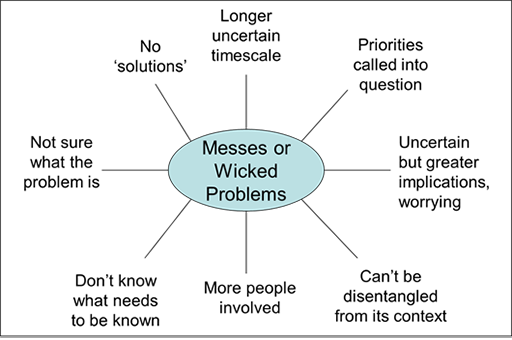2.3 Tame problems, messes and wicked problems
Many problems have tried and tested solutions, or standard ways of working out a solution, and they do not need a particularly ‘creative’ approach – these are often called tame problems. For example, if I find I have no food in my kitchen, I don’t usually have to be creative about solving that problem – I can just go the shops or order a home delivery. It’s only in less usual circumstances (I’ve got people coming to a dinner party, or I’m living miles from the nearest town) that I might need a creative solution to that situation.
While many challenges in organisational life are straightforward and routine tame problems, sometimes they conceal what academics have named variously as ‘messes’ (e.g., Russell Ackoff in The future of operational research is past, 1979) or ‘wicked’ problems (H. J. W. Rittel, 1972).
Messes and wicked problems are complex sets of problems in which many different potential issues are interlinked. These problems may be closely linked to the differing values, perceptions and world views of the people who are involved in aspects of the situation.
The following diagram summarises the key elements of messes or wicked problems:
Activity 4 Tame or wicked?
Spend a few minutes reflecting on two or three challenging issues that concern you at the moment and some of the stakeholders involved.
For each issue, write down a list of stakeholders involved – people who can affect it or are affected by it. In your mind, try to step into each stakeholder’s shoes so that you get some feel for how that party sees your issue. Write a sentence or two about the problem from the point of view of each of these stakeholders. Perhaps make a few notes about some of the more marked differences that emerge from this exercise.
Work through the characteristics outlined in the diagram above and see how they apply to your issues. If ‘1’ means ‘very tame’ and ‘10’ means ‘very wicked’, what score would you give these issues?
Discussion
Messes or wicked problems do not respond readily to conventional approaches to problem solving – if it were that straightforward to solve the problem, it wouldn’t be a messy one. Messy issues call for new approaches, different from what has been tried before, and are likely to need solutions that are tailored to that particular situation.
Managing messes or wicked problems usually needs a lot of patient exploration and consideration of the issue, backed up with ways of ‘mapping’ the situation so that you can see how all the bits fit together.
Wicked problems may have no neat and tidy ‘solution’ at all, or no single solution. Often they boil down to finding acceptable ways of coping, both collectively and personally, or of finding a compromise between different initial starting points – also known as ‘satisficing’.
Problems in these areas can easily become very ‘political’, raising issues such as trust, respect, role and communication, so discussion, debate and negotiation are often critically important if you are to make good progress.
In practice, the complexity of many situations often means that it may be better to think of continuous, ongoing ‘problem management’ rather than one-off ‘problem solving’ with a clear beginning and end. For people working in community policing, the individual episode may well be just one issue in a continuing portfolio of issues. The resolution of one issue often results in a changed environment that raises new issues.

